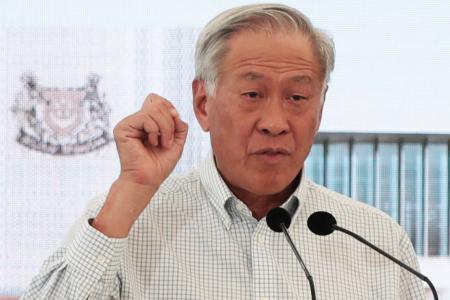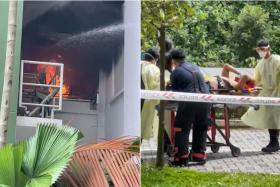NSF hurt in Taiwan parachute training first such case since 1974: Ng
While Private Joshua Quek was doing the fifth and final jump for his Basic Airborne Course at night, the cord that attached his parachute to the aircraft interfered with his jump when it was not pulled taut, as required.
The cord, called the static line, swept across his neck as he exited the aircraft.
This caused a neck injury, even as the Singapore Armed Forces (SAF) full-time national serviceman landed within the designated zone.
The incident in Taiwan on Dec 18 last year occurred as a result of a known risk for static-line parachute training termed "static-line interference", said Defence Minister Ng Eng Hen yesterday.
It was the first such known incident to result in serious injury since the Basic Airborne Course started in 1974, he said, adding that investigations are underway to determine why this interference occurred and if adequate supervision was given during the jump.
Dr Ng was responding to a question by Aljunied GRC MP Pritam Singh, who had asked the minister for the facts and interim findings surrounding the incident.
In his written reply, Dr Ng said the SAF conducts about 6,000 static-line parachute jumps annually.
Since 1974, about 27,000 Basic Airborne Course trainees have graduated.
To ensure static-line interference does not occur, Dr Ng said there were established drills and safety protocols in the training manuals for both the jumper and the jump master.
"For all jumps, a qualified jump instructor is required to be on board the plane with two qualified jump masters at the exit door to check that these measures and other safety aspects are adhered to," he said.
Pte Quek, 21, had completed the previous four static-line jumps successfully in the days prior to the incident, and had successfully undergone the required pre-jump qualifications, training drills and safety briefs before taking part in this activity, he added.
Upon landing, Pte Quek was attended to immediately by SAF's on-site medical officer and later evacuated by the on-site ambulance to the nearest tertiary hospital.
There, a magnetic resonance imaging scan revealed he had sustained a cervical spine injury.
The next morning, he underwent surgery to relieve the pressure on his spine.
A planned second surgery on Dec 21 to stabilise his cervical spine was also successfully completed, said Dr Ng, adding that the soldier is still in the intensive care unit for close observations.
He said that Pte Quek is now able to breathe on his own and talk to his family, but will require continued rehabilitation and physiotherapy for long-term recovery.
Pte Quek's family was informed on the night of the incident and his mother was flown to the hospital the next day. His father and brother joined him a few days later.
A formal Board of Inquiry, supported by the SAF Inspector General's Office, has been convened by the Singapore Army for a full investigation of this incident, said Dr Ng.
In the meantime, all static-line parachute jumps have been suspended.
FOR MORE PARLIAMENT REPORTS, READ THE STRAITS TIMES
Get The New Paper on your phone with the free TNP app. Download from the Apple App Store or Google Play Store now


